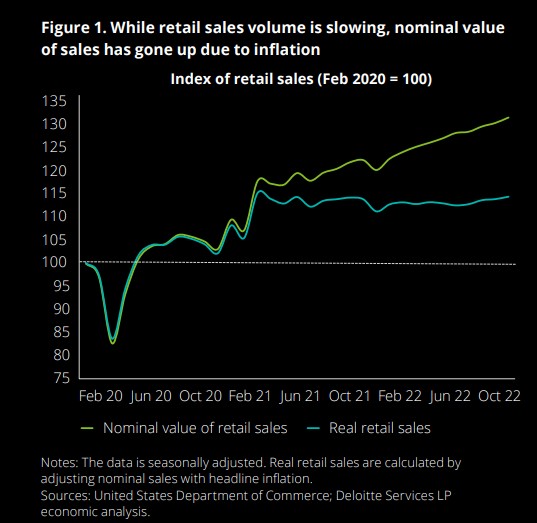 By Varnika Jain,
By Varnika Jain,
Impact Analytics Senior Business Analyst
Consumer packaged goods (CPG) companies and retailers have confronted high volatility over the past three years. After battling through the pandemic’s supply shocks, subsequent high inflation, and other unpredictable market conditions, these enterprises may not be very confident about their chances to improve profitability. Yet the market outlook is not all gloomy. For example, even though inflation has weakened customer purchasing power, consumer spending is still strong.
To make the journey ahead truly transformational, retailers need to shun traditional planning systems and tap the full potential of data and AI-powered analytics.
 In the post-pandemic world, customer interaction with retailers has evolved. The use of technology has grown and permanently altered the way consumers behave. Customers are more demanding than ever—which is really saying something! They insist on the best products at the best prices delivered with utmost convenience. Accordingly, companies must not only create an optimal mix of products but also ensure their availability at the right place and time. But how?
In the post-pandemic world, customer interaction with retailers has evolved. The use of technology has grown and permanently altered the way consumers behave. Customers are more demanding than ever—which is really saying something! They insist on the best products at the best prices delivered with utmost convenience. Accordingly, companies must not only create an optimal mix of products but also ensure their availability at the right place and time. But how?
By harnessing artificial intelligence to generate deep, data-driven insights into ever-evolving consumer shopping behavior and their most profitable products, optimizing their assortment and thus driving sales growth and increasing profitability.
1. Make Accurate Buying Decisions with Advanced Demand Forecasting
Accurate demand forecasting is critical to improve retail assortment planning. Relying solely on past performance analysis and traditional forecasting methods is ineffective and inefficient when customers’ preferences shift so quickly. Inaccurate forecasts impact buying decisions for the upcoming season as well as the current one.
Modern retail assortment planning tools are backed by powerful forecasting engines, pulling in both external and internal demand-influencing factors. These engines support “regime shifting,” “prophet,” and other advanced forecasting models informed by recent data and numerous macro exogenous inputs including inflation rate, consumer confidence data, and Google mobility information. These models harness the power of AI to accurately predict demand, which is crucial in an industry where trends evolve rapidly.
2. Use Intelligent Store Clustering to Create Retail Assortment Plans
Store clustering is foundational to developing accurate retail assortment plans. Creating store clusters involves assessing multiple factors such as historical sales volume, store size, gross margins, and units sold. These factors change with evolving demographics and customer preferences, so it is essential that retailers continually re-evaluate store clustering.
Traditional retail assortment planning tools, such as spreadsheets, are not capable of managing all the information needed to create ideal clusters. Compare that to AI-based clustering tools, which use complex algorithms such as principal component analysis, for selecting the optimal variables. These tools also evaluate multiple algorithms—such as K-means, mini batch K-means, and mean shift—to determine the best cluster-creation model. In addition, these clustering tools offer retailers the flexibility to run clustering with their own set of store and product variables, giving them confidence in the validity of their results.
3. Ensure the Availability of the Right Products in the Right Sizes
Assortment planning that neglects sizing fails to fulfill its purpose. Online and in-store fashion shoppers, particularly those looking for apparel and footwear, often find that their preferred product is not available in their size; in such instances, the mere availability of the desired product is inconsequential. A poor customer experience indeed.
It’s crucial for retailers to get the right size curve when making assortment decisions. AI-based analytical tools simplify this process—from automatically identifying size ranges to building optimal size curves for planning.
4. Get Granular Recommendations by Leveraging the Right Attribute Mix
Many retailers operate a network of stores spanning not just states but countries and continents. Store size and shelf space vary by region, as do local consumer preferences for various product attributes, which of course influences product performance.
For fashion products such as apparel, retailers must find the right mix of product attributes (such as sleeve length, fit, and silhouette) along with store attributes (such as store size, units sold per store, gross margins, sales, and gross margin return on investment) to determine how to categorize a store.
Additionally, complementary products, which are typically bought together, require similar types of assortments. Traditional assortment techniques consider each product independently of one another; overlooking their interdependency hampers the accuracy of retail assortment planning decisions. AI tools take into account the right set of store and product attributes plus these interdependencies to generate the optimal product-store- or product-store-cluster-level recommendations. These recommendations not only optimize shelf space but also enable customers to find what they want quickly, without being overwhelmed with too many choices.
5. Increase Retail Assortment Planning Efficiency by Optimizing Multiple Simulations
Whereas traditional methods for managing assortment planning are very time- and resource-consuming, prone to manual errors, and incapable of processing large data sets, modern retail assortment planning is a complex, iterative endeavor that automatically crunches the most recent data to ascertain changing trends, demands, preferences, and market outlook.
AI-powered tools empower retailers and suppliers to continuously improve their assortment plans. Such systems quickly run thousands of simulations to develop assortments that fit the brand’s goals. Multiple simulations ensure retailers determine what adjustments will likely affect the forecast, and identify its effects across sales, margins, and other factors. This level of optimization is not possible using traditional methods.
Take the Next Step
Impact Analytics AssortSmart™ enables retailers to improve gross margins and boost sales, providing the flexibility to make necessary adjustments at each step of the retail assortment planning process. Use it to create the optimal plans so your customers always have access to the right product at the right place and right time.





